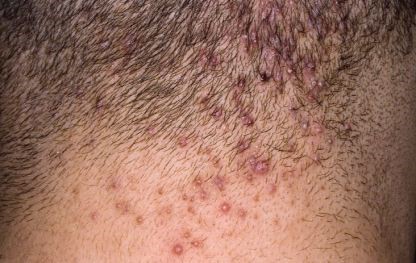
A 20-year-old African American man with no significant past medical history presents to the dermatology clinic with a mildly pruritic, painless scalp rash that began three years ago following a close-shave haircut.
Multiple lesions developed in the occipital region of the scalp and persisted, becoming irritated with hair brushing and occasionally bleeding, particularly with skin picking.
The condition negatively impacts the patient’s self-confidence and limits his hairstyle options.
He has previously been prescribed oral amoxycillin, ketoconazole shampoo, and hydrocortisone lotion, to no effect.
On examination, there are multiple skin-coloured exophytic nodules, less than 0.5cm in diameter on the occipital region.
There is no associated scale, alopecia, purulence, or erythema. No other sites are
What is the most likely diagnosis?
Correct!
Acne keloidalis nuchae, also known as folliculitis keloidalis nuchae, is a common disorder caused by chronic irritation or occlusion of hair follicles at the posterior neck and occipital scalp leading to the formation of keloid-like scars and scarring alopecia.
Active lesions may be painful, pruritic, and have contact bleeding. The pruritus associated with this condition contributes to a cycle of itching, scratching, irritation and inflammation.
The diagnosis is clinical, without the need for biopsy. On examination, early presentations appear as erythematous papules and pustules.
Over time, fibrosis causes variably sized keloidal papules, plaques or nodules.
Triggers include hair cutting practices such as close shaving, friction (eg, helmets, tight shirt collars), heat and/or humidity.
Young males with afro-textured hair are most prone to this condition because when coarse, curly hair is cut short, the hair shafts can re-enter the skin a short distance from the follicle after exiting the skin (termed extrafollicular penetration) or through piercing the follicular wall without emerging from the skin surface (termed transfollicular penetration), leading to inflammation.
Genetic factors may also play a role, the presence of substitution mutation in 1A helical segment of follicle-specific keratin 75 increases the risk of the condition by sixfold.
To limit progression, counsel patients to avoid close shaving, frequent haircuts, friction, rubbing, and skin picking.
Management of mild disease involves a combination of high potency topical steroids (eg, clobetasol 0.05%), antimicrobial wash (eg, chlorhexidine, povidone iodine), topical retinoids (eg, tazarotene 0.05% or 0.1%), with the addition of topical antibiotics (eg, clindamycin phosphate 1%) if mild pustules are present.
Topical steroids should be applied 1-2 times daily and alternating in two-week cycles to minimise the side effects of long-term use.
The condition often improves within 6-8 weeks of treatment, but treatment should be continued until clinical signs and symptoms resolve.
If infection is suspected, a culture should be performed and a course of appropriate antibiotics completed prior to starting steroid treatment.
If firm papules or keloid-like scars are present, intralesional triamcinolone injections (2.5-40mg/mL) can be administered at four-week intervals to soften and decrease the size of the lesions.
Treatment-resistant or moderate to severe acne keloidalis nuchae requires systemic treatment with oral antibiotics (doxycycline or minocycline) for several weeks to months.
Seborrhoeic dermatitis is caused by overgrowth of Malassezia furfur, a yeast that colonises the skin.
This presents as large, greasy yellow plaques on the scalp or other areas and typically improves with use of antifungal shampoos.
Scalp psoriasis is a chronic condition that presents with erythematous, thickened, well-demarcated patches or plaques with silver scale on the scalp.
Tinea capitis is a fungal infection of the scalp caused by dermatophyte species (microsporum, trichophyton).
A kerion is an advanced form of inflammatory-type tinea capitis that presents as a painful, purulent nodule with associated scarring alopecia.
